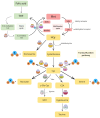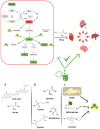Transsulfuration Pathway Products and H2S-Donors in Hyperhomocysteinemia: Potential Strategies Beyond Folic Acid
- PMID: 40650206
- PMCID: PMC12249890
- DOI: 10.3390/ijms26136430
Transsulfuration Pathway Products and H2S-Donors in Hyperhomocysteinemia: Potential Strategies Beyond Folic Acid
Abstract
The transsulfuration pathway plays a central role in the regulation of sulfur metabolism and contributes to the maintenance of cellular homeostasis. Starting from homocysteine, a sulfur-containing amino acid derived from methionine via the methionine cycle, this metabolic pathway supports the biosynthesis of cysteine and other downstream products, such as taurine, serine, reduced glutathione and the gasotransmitter hydrogen sulfide (H2S). The most common disruption of this pathway leads to hyperhomocysteinemia (HHcy), a well-known risk factor for the development of cardiometabolic diseases and other pathological conditions. In this context, identifying effective pharmacological strategies is crucial. Based on both preclinical and clinical evidence, this review provides an updated overview on the role of folates in restoring transsulfuration balance in HHcy and explores the potential effects of downstream products (such as serine, taurine, and precursors of glutathione) under HHcy conditions. Finally, it examines the pharmacological properties of H2S-donors in cultured cells exposed to HHcy and in animal models of HHcy. This summary of the literature offers new perspectives for the treatment of HHcy and the prevention of its associated multiorgan complications.
Keywords: homocysteine; hydrogen sulfide; hyperhomocysteinemia; sulfur compounds; transsulfuration pathway.
Conflict of interest statement
The authors declare no conflicts of interest.
Figures



Similar articles
-
Folic acid with or without vitamin B12 for cognition and dementia.Cochrane Database Syst Rev. 2003;(4):CD004514. doi: 10.1002/14651858.CD004514. Cochrane Database Syst Rev. 2003. Update in: Cochrane Database Syst Rev. 2008 Oct 08;(4):CD004514. doi: 10.1002/14651858.CD004514.pub2. PMID: 14584018 Updated.
-
Homocysteine-lowering interventions for preventing cardiovascular events.Cochrane Database Syst Rev. 2017 Aug 17;8(8):CD006612. doi: 10.1002/14651858.CD006612.pub5. Cochrane Database Syst Rev. 2017. PMID: 28816346 Free PMC article.
-
Analysis of MTHFR, CBS, Glutathione, Taurine, and Hydrogen Sulfide Levels in Retinas of Hyperhomocysteinemic Mice.Invest Ophthalmol Vis Sci. 2017 Apr 1;58(4):1954-1963. doi: 10.1167/iovs.16-21247. Invest Ophthalmol Vis Sci. 2017. PMID: 28384716 Free PMC article.
-
Atherogenic Effect of Homocysteine, a Biomarker of Inflammation and Its Treatment.Int J Angiol. 2024 Jul 8;33(4):262-270. doi: 10.1055/s-0044-1788280. eCollection 2024 Dec. Int J Angiol. 2024. PMID: 39502352 Free PMC article. Review.
-
SAH is a major metabolic sensor mediating worsening metabolic crosstalk in metabolic syndrome.Redox Biol. 2024 Jul;73:103139. doi: 10.1016/j.redox.2024.103139. Epub 2024 Apr 27. Redox Biol. 2024. PMID: 38696898 Free PMC article.
Cited by
-
Do Sex and Gender Interact with the Biological Actions of Taurine? A Critical Rereading of the Literature.Int J Mol Sci. 2025 Aug 21;26(16):8097. doi: 10.3390/ijms26168097. Int J Mol Sci. 2025. PMID: 40869416 Free PMC article. Review.
References
Publication types
MeSH terms
Substances
LinkOut - more resources
Full Text Sources
Medical

